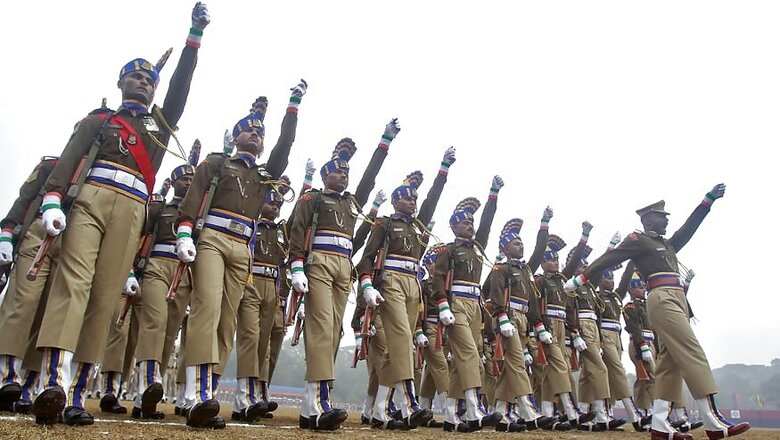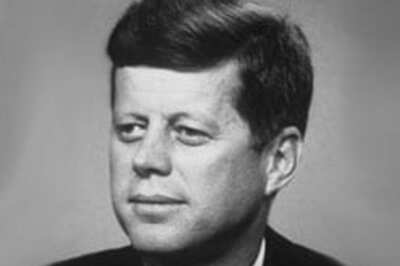
views
New Delhi: It is impossible to be sure if an armoured convoy would have reduced the death toll in Thursday’s suicide attack. What remains a fact is that the demand for an armoured convoy and “better support” from the Centre has persisted for years, but to little avail.
By Friday morning, the death toll had climbed to 40 – with several more injured in the single worst terror attack in the Valley after a suicide bomber rammed his Scorpio SUV laden with explosives into a CRPF bus in south Kashmir. The Jaish-e-Mohammad claimed responsibility for the attack.
In September 2017, Home minister Rajnath Singh had rued the “delay” in the supply of weapons and critical equipment to the CRPF by the defence ministry, and argued that there was a need to develop a framework involving defence PSUs to address the issue. Singh, while speaking at an event at the DRDO, had said, “There is a need to think over it as they suffer due to the delay. I think a framework for it has to be developed.” Newly appointed defence minister, Nirmala Sitharaman, had agreed: “The CRPF does not get the priority it should.”
Singh had added that the forces CRPF was trying to combat were using “latest technologies”. “While sitting in any part of the world, anybody can make anyone a terrorist, they can hack…. We will have to equip ourselves with latest technologies to combat them.”
But in the past months, little has changed on the ground, said officers while adding that unless systemic changes are implemented at a war-footing, the CRPF would continue to be “sitting ducks”.
By July 2018, faced with a “tedious” procurement process, the CRPF had taken matters into its own hands and attempted to armour plate the many vehicles and troop carriers it had through “improvisation” – sourcing locally available metal sheets, concrete and wooden planks to create a makeshift aegis.
"We are trying to acquire more bulletproof vehicles (for deployment in Kashmir). Since the rate of procurement and procurement through suppliers is a tedious process...we decided to improvise. We have asked our units to use local material and bring in local vendors to do the job," CRPF Director General R R Bhatnagar had told reporters on the eve of the 78th Raising Day of the paramilitary force.
The improvisation was described as a “short-term measure”, with the force trying to “partially bulletproof” their buses, with the DG adding that it was witnessing procedural issues and that the government was "actively considering" to expedite the process.
A serving officer, who didn’t wish to be named, added, “The CRPF, is on paper, the premier central police force. And this is what they’re been reduced to – trying to bulletproof their buses with wood and metal sheets, bought from a local store.”
The CRPF is among the oldest and most key central police forces of India and was raised to combat the political unrest and the agitations in the then princely States of India following the Madras Resolution of the All-India Congress Committee in 1936. An Act in the Parliament constituted it as an armed force of the Union and the then Home minister Sardar Vallabhbhai Patel envisioned it as having a “multi-dimensional role” that would be able to deal with “the changing needs of a newly independent nation.”
From helping the Union government, bringing different princely states into the fold in the early 1950s and checking infiltration and trans-border crimes in subsequent decades to its deployment in the north-east to counter insurgency, the CRPF has been deployed in diverse areas for equally diverse purposes.
What this has meant is that the CRPF’s role is among the most diverse – from “crowd control”, “riot control” and “protection of local flora and fauna” and “protection of VIPs” on the one hand, to “counter militancy / insurgency operations” and “dealing with Left-wing extremism” on the other hand.
“In the present scenario, the CRPF is like a fail-safe. It is the most relied upon by the Union government and we are deployed for diverse reasons. From Kashmir to fighting Naxals, we are at the forefront with little support,” said a senior officer who didn’t wish to be named.
In spite of this, the CRPF continues to be plagued with vacancies. As per the MHA, the CRPF had a total of 21,000 posts lying vacant – accounting for nearly 40 percent of the total vacancies of all paramilitary forces in the country.
Former CRPF DG Durga Prasad explained, “Even if someone fires a weapon, loss of life is minimised in the case of an armoured convoy. But if you see the type of situation we are seeing right now – when a vehicle rams into yours – it is different.”
Prasad said that while it was impossible to have someone man every junction, entry and exit point at the highway, “airlifting troops” would have been ideal and could have prevented the loss of lives.
“The loss of life is a thousand times worse than any loss in finance. If you see the remains of the vehicle, it is just a mangled mass of steel. I won’t even call the financial cost of air lifting as a financial loss – but a financial charge,” he added.
The former DG isn’t the only one asking why the CRPF were asked to travel in a convoy. After former J&K chief minister Mehbooba Mufti posed the same question, the state's ex-top cop said that he had proposed to airlift soldiers to avoid Pulwama-like tragedies.
Reacting to the development, former J&K DGP SP told News18 on Friday: "The transit alone takes a lot of time, especially when the roads are closed for weeks. This exposes the soldiers for a prolonged duration. I had proposed to airlift the jawans during a high-level security meeting of joint forces more than once, and also to representatives of state and Union governments."
The primary opposition to such an idea, he realised, would be the costs involved. But, Vaid said, in his presentations he had shown, based on his calculations, that the cost difference in airlifting soldiers to and from Kashmir was “comparable” to the costs involved in bringing in and out of the Valley by road.




















Comments
0 comment